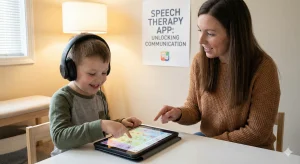At-Home Occupational Therapy for Autism | Calming & Fun Ideas
By Wellness Hub
Last Updated: October 27, 2025
Ever notice how your child suddenly calms down when swinging, squeezing playdough, or getting a big bear hug? That’s not just play — it’s therapy in action.
For many parents of children with autism, everyday moments at home can become powerful opportunities to build focus, body awareness, and emotional balance. That’s exactly what at-home occupational therapy is all about — turning ordinary play into skill-building magic.
In this guide, you’ll learn simple sensory and fine-motor activities designed by occupational therapists to help your child feel calmer, stay focused longer, and handle daily routines with more confidence. Whether you’re new to OT or already working with a therapist, these at-home strategies for kids aged 2–6 will fit naturally into your day — no fancy tools required.
Because sometimes, the best therapy happens right where your child feels safest — at home, with you.
What Is Occupational Therapy for Autism?
Occupational therapy (OT) for autism is all about helping children learn, play, and grow in ways that match their unique strengths and challenges. For many kids on the autism spectrum, everyday tasks like dressing up, holding a pencil, sitting still, or managing big emotions can feel overwhelming. That’s where occupational therapy for kids steps in — not to change who your child is, but to help them participate more confidently in daily life.
At its core, OT focuses on improving daily living, sensory, and fine-motor skills. Therapists use structured play, sensory-based activities, and real-life routines to help children build attention, balance, and body awareness. For example, a simple game of squeezing a stress ball strengthens fine-motor control, while a sensory swing helps a child regulate their movement and focus better during play or mealtimes.
Another important part of OT is sensory integration — the process of helping children understand and respond to the sensations around them. Many autistic children are extra sensitive to sound, touch, or movement. Through gentle, repetitive sensory play, therapists help them feel calmer and more in control of their body’s responses.
Ultimately, the goal of occupational therapy is to support independence at home, in school, and in the community. Whether it’s tying shoelaces, joining a group activity, or managing transitions, every small step builds confidence.
Also read: 0–12 Month Guide: Early Signs Baby Needs Occupational Therapy
How At-Home OT Helps 2–6-Year-Olds
Early childhood is when a child’s brain grows and learns the fastest — which makes these years the perfect time to start at-home occupational therapy (OT). Between ages 2 and 6, children are developing the foundation for attention, coordination, and emotional control. When parents bring therapy ideas into daily routines, those skills strengthen naturally through play, movement, and connection.
Here’s how at-home OT makes a difference:
Consistency accelerates therapy progress:
Children thrive on repetition. Practicing the same calming or fine-motor activities at home reinforces what they learn during therapy sessions. Over time, this consistency helps new skills stick — from grasping crayons to staying seated during meals
Parents become active partners in growth:
When you join in your child’s OT games — crawling through tunnels, squeezing playdough, or rolling a therapy ball — you’re not just playing; you’re modeling confidence and engagement. Active parent involvement turns therapy into bonding time, building trust and emotional safety.
Familiar spaces build comfort and confidence:
At home, children feel secure. Doing OT activities in familiar surroundings helps them focus better and explore new skills without fear or pressure. The kitchen floor can become a mini obstacle course, or a living-room pillow fort can double as a sensory zone — simple setups that build big developmental gains.
Early intervention shapes lifelong habits:
According to the World Health Organization (WHO) and Autism Speaks, early-intervention programs that include family-based therapy lead to stronger communication, sensory regulation, and social outcomes in young children with autism. Starting early — and practicing daily — helps wire these positive patterns into long-term success.
Read more: Occupational Therapy for 2-Year-Olds: A Parent’s Guide
Calming Sensory Activities for Autism
For many children on the autism spectrum, the world can sometimes feel “too much” — too bright, too noisy, too fast. Calming sensory activities help your child feel safe, balanced, and in control of their body. These activities don’t just calm the mind; they gently teach the brain how to organize and process sensory information better, improving attention, focus, and self-regulation over time.
Here are some simple, therapist-recommended sensory play ideas you can try at home:
Deep-Pressure Play (Grounding Through Touch):
Activities that involve firm, even pressure — like bear hugs, rolling a therapy ball over your child’s back, or wrapping them snugly in a soft blanket “burrito” — give calming feedback to the body. Deep-pressure play supports sensory balance and helps children feel grounded after a long or overstimulating day. According to the American Occupational Therapy Association (AOTA), deep-pressure input helps regulate the nervous system and improves focus and calmness in children with sensory processing challenges.
Movement Breaks (Regulating Energy Levels):
Short bursts of movement help children release built-up energy and refocus. Try swinging, crawling through tunnels, jumping on a mini trampoline, or pushing a laundry basket filled with pillows. These calming sensory activities engage the body’s vestibular and proprioceptive systems — essential for balance and coordination. Encourage your child to take “movement breaks” between tasks like homework, meals, or transitions to prevent meltdowns before they start.
Water Play (Soothe and Relax):
Water has a natural calming effect. Let your child pour, scoop, or splash in a small tub during bath time or outdoor play. Add soft sponges, cups, or toy animals to make it interactive. Water play promotes relaxation and sensory balance while improving fine-motor control.
Tactile Play (Exploring Textures Safely):
Some children crave touch, while others avoid it. Introduce gentle tactile play with materials like rice bins, kinetic sand, or soft fabric squares. Let your child explore textures at their own pace — never force contact. Over time, tactile play helps reduce touch sensitivities and encourages curiosity.
Quiet Corners (A Calm Retreat Space):
Create a cozy nook at home with soft cushions, a weighted blanket, and your child’s favorite calming toy. Add dim lighting or gentle music. Having a safe retreat where they can self-regulate teaches children independence in managing sensory overload. The American Speech-Language-Hearing Association (ASHA) notes that sensory regulation strategies — such as quiet zones and calming play — support communication, attention, and participation in daily routines.
When practiced regularly, these calming sensory activities help your child’s body and mind work together more smoothly. Over time, you’ll notice fewer meltdowns, better transitions, and more moments of calm connection — all from a few minutes of mindful play each day.
Fine Motor Skill Activities for Focus and Control
Strong hands build confident learners. Between ages 2 and 6, children rely on fine-motor skills for nearly everything — from holding a spoon and zipping a jacket to coloring, cutting, and eventually writing. These small but mighty movements form the foundation for school readiness and independence in daily routines.
When a child has weak finger strength or poor grasp control, tasks that seem simple can feel frustrating. That’s why preschool OT activities focus on fun, hands-on ways to strengthen coordination, control, and endurance — without feeling like “therapy.”
Here are some step-by-step fine-motor activities you can easily do at home:
| Activity | How to Do It | Skills Strengthened |
|---|---|---|
| Play-Doh Pinches | Roll and pinch Play-Doh into tiny balls, snakes, or shapes. Encourage using thumb and index finger (“pincer grasp”). | Builds finger strength and coordination for writing and self-feeding. |
| Threading Beads or Pasta | Use shoelaces or pipe cleaners to thread beads, buttons, or dry pasta. Start with large beads, then move to smaller ones. | Improves hand-eye coordination, concentration, and bilateral hand use. |
| Clothespin Games | Have your child clip and unclip clothespins onto a box, rope, or picture cards. Make it fun by sorting colors or counting. | Strengthens finger muscles needed for grasp control and pencil pressure. |
| Sticker Pick-Up | Peel and place small stickers on paper or along a line. | Enhances fingertip precision and visual-motor integration. |
| Sponge Squeeze | Fill two cups with water and have your child transfer water using a sponge or dropper. | Builds hand strength and endurance for self-care tasks. |
Therapist Tip: Turn these into short “hand warm-up” sessions before coloring or writing time. A few minutes of playful squeezing, pinching, or threading can make a big difference in control and focus.
Incorporating these fine-motor skill activities into your child’s daily routine not only prepares them for classroom tasks but also builds confidence in doing things on their own — one pinch, one bead, one proud smile at a time.
Creating a Daily Sensory Routine at Home
Every child’s day flows better with a little rhythm and predictability — especially for kids on the autism spectrum. A daily sensory routine, often called a sensory diet, provides your child’s body and brain with the right kind of input they need to stay focused, calm, and organized. Think of it as a “recipe” for balanced energy and emotional regulation throughout the day.
The goal isn’t to add more work; it’s to blend short, meaningful sensory breaks into your child’s regular routine. When done consistently, this structure reduces meltdowns, improves attention, and builds self-regulation — key goals in occupational therapy for kids.
Here’s a simple way to design your child’s daily sensory routine at home:
| Time of Day | Example Activities | Sensory Focus | Purpose/Benefit |
|---|---|---|---|
| Morning Wake-Up | Animal walks, wall push-ups, jumping jacks | Proprioceptive Input (Body Awareness) | Helps the body “wake up,” improves alertness and focus. |
| Mid-Morning Playtime | Swinging, crawling through tunnels, scooter board rides | Vestibular Input (Movement & Balance) | Builds coordination and prepares for sitting tasks. |
| Before Meals | Deep-pressure bear hugs, hand squeezes, or “sandwich squeezes” with pillows | Calming Input | Regulates sensory arousal before structured times like eating. |
| Afternoon Quiet Time | Weighted blanket rest, storytime in a calm corner, gentle back rubs | Deep Pressure & Tactile Input | Reduces overstimulation; supports emotional regulation. |
| Evening Wind-Down | Warm bath, soft music, dim lights | Multi-Sensory Relaxation | Signals the body to slow down, promoting better sleep. |
Parent Tip:
Visual schedules — with pictures of each activity — help your child know what’s coming next. You can hang one on the wall or use a simple app. Kids thrive when they can see their day laid out in a predictable flow.
Include “Heavy Work” Moments:
Heavy work (like carrying books, pushing furniture, or pulling a resistance band) provides proprioceptive input, which helps calm and organize the nervous system. A few minutes of heavy work before transitions — such as before meals or homework — can make a big difference in focus and mood.
By weaving these activities into your family’s everyday rhythm, your child’s sensory needs are supported naturally — making the day smoother, calmer, and more joyful for everyone.
Simple Tools to Support Home OT
You don’t need an expensive clinic setup to bring the benefits of occupational therapy (OT) into your home. Many of the best OT tools are already part of your daily environment — hidden in your drawers, kitchen, or playroom. The right materials simply help your child explore touch, movement, pressure, and control in fun, developmentally meaningful ways.
Here’s a list of simple, affordable OT tools and sensory kit ideas every parent can start with:
Resistance Bands
Great for stretching, pulling, and pushing games. Wrap them around table legs for seated exercises or use them in “tug of war” play. Resistance bands provide deep muscle feedback, improving strength, coordination, and attention.
Therapy Putty or Play-Doh
Squeeze, stretch, and hide small beads or coins inside for your child to find. These activities strengthen finger muscles, improve grip, and build fine-motor endurance for writing and self-feeding.
Rice or Bean Sensory Bins
Fill a tub with rice, beans, or lentils and add scoops, spoons, or toy animals. This classic sensory play helps children explore textures, calm their senses, and practice hand-eye coordination.
Swings or Hammocks
Gentle swinging offers soothing vestibular input, helping children regulate movement and balance. Even a simple indoor hammock or door-frame swing can transform playtime into therapy time.
Weighted Items
A small weighted lap pad, stuffed animal, or blanket can help children who struggle to sit still. The gentle weight provides a calming, grounding effect that improves focus during meals or homework.
Everyday Household Tools
You don’t always need special equipment! Try using clothespins for grasp games, sponges for squeezing, kitchen tongs for picking up toys, or empty water bottles for homemade bowling. These familiar items make therapy at home natural, affordable, and engaging.
Visual and Sensory Aids
Simple items like visual schedules, textured mats, or chewable necklaces support structure and self-regulation for children with sensory sensitivities.
By setting up a small corner with a few of these OT tools, you can create a calm, fun, and sensory-rich space right at home — helping your child grow stronger, more focused, and more confident every day.
Conclusion
Helping your child grow doesn’t need special equipment or long therapy hours — it just needs love, patience, and play. With simple at-home occupational therapy activities, you can boost your child’s focus, coordination, and confidence right in your living room. Whether it’s squeezing putty, swinging, or cuddling under a blanket, every small moment supports their sensory balance and independence. Remember, progress happens step by step — and you’re your child’s best therapist at home. If challenges continue, connect with a qualified occupational therapist for extra support and guidance. Together, you can make every day a learning adventure.
Frequently Asked Questions:
1. What age should I start occupational therapy at home?
You can start simple sensory play and fine-motor activities anytime. For children showing early autism signs, experts recommend starting by age 2–3 under the guidance of a pediatric occupational therapist.
2. Can I do occupational therapy without special equipment?
Yes! You can do OT at home using daily household items — pillows, rice bins, spoons, sponges, or Play-Doh all work great for sensory and motor play.
3. How long should each OT activity last?
Keep sessions short and fun — 5 to 10 minutes is ideal. Small, frequent activities help your child stay focused and make learning easier.
4. How do I know if my child enjoys sensory play?
Look for smiles, calm breathing, and focus. If your child pulls away, covers their ears, or looks upset, the activity may be too strong — simply make it gentler.
5. What is a sensory diet in occupational therapy?
A sensory diet is a planned daily routine that includes calming and active play. It helps children with autism manage their energy, focus better, and stay balanced throughout the day.
6. What are the best calming activities for autism at home?
Try deep-pressure play, swinging, water play, or squeezing a stress ball. These activities help your child feel grounded and reduce meltdowns.
7. How can I help my child improve fine-motor skills at home?
Encourage fun tasks like threading beads, pinching Play-Doh, or using clothespins. These strengthen small muscles needed for writing, dressing, and eating.
8. How often should I do sensory activities with my child?
Include short sensory breaks 2–3 times a day — morning, afternoon, and evening. A consistent routine keeps your child calm and focused.
9. What if my child resists certain textures or sounds?
Start slow and respect their limits. Offer gentle exposure through fun play, like exploring textures with a spoon or soft cloth. Over time, comfort usually increases.
10. When should I see a professional occupational therapist?
If your child often avoids touch, struggles with daily tasks, or shows frequent meltdowns, it’s best to consult a licensed pediatric occupational therapist for personalized guidance.
About Author:
Sonali Sharma, Occupational Therapist
Sonali Sharma is a skilled Occupational Therapist at Wellness Hub, with over three years of experience in supporting children with developmental, behavioral, and learning challenges. She holds a Bachelor’s in Occupational Therapy (BOT) from Amity University and has worked with leading institutions such as NIMHANS Bengaluru and ESIC Hospital Faridabad.
At Wellness Hub, Sonali provides online occupational therapy sessions tailored to each child’s needs. She specializes in pediatric therapy, autism support, sensory integration, and developmental skill-building, helping children strengthen motor skills, improve focus, and become more independent in daily life.
Her therapy style is child-centered, play-based, and evidence-driven—making sessions both effective and enjoyable for kids. Sonali also equips parents with practical home therapy strategies to extend progress beyond sessions.
Passionate about empowering families, Sonali believes in creating a nurturing space where children can thrive while parents feel supported every step of the way.
Book your Free Consultation Today
Parent/Caregiver Info:
Client’s Details:
* Error Message








